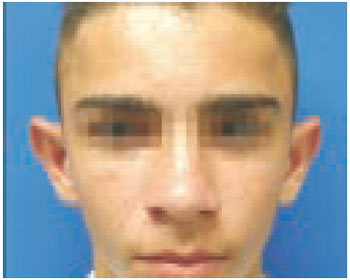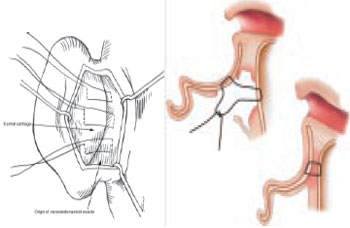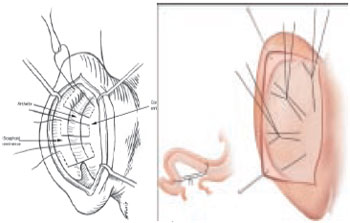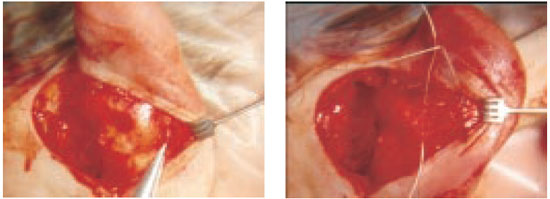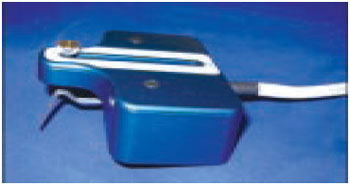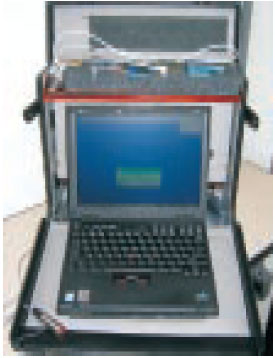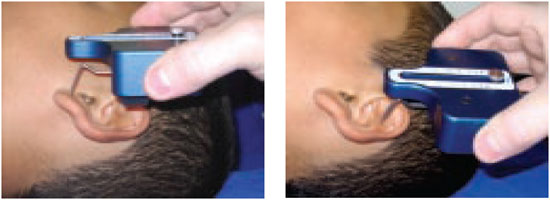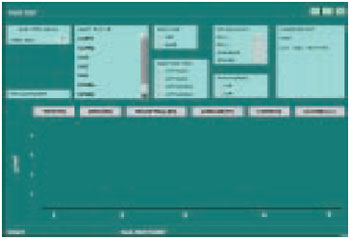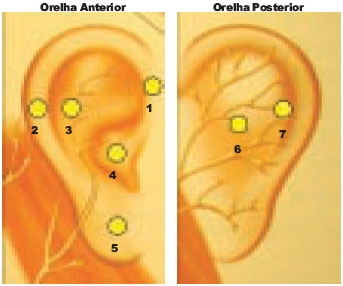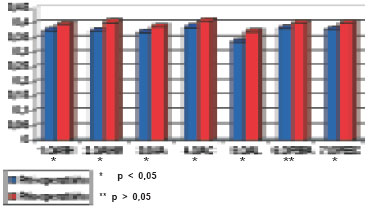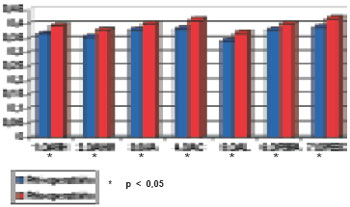ABSTRACT
Objective: To compare the ear tactile sensibility before and after otoplasty to correct prominent ears, through measurement of cutaneous pressure and movement threshold by Pressure Specified Sensory DeviceTM (PSSD). Methods: Prospective study, evaluating 15 patients with prominent ears, which were treated with bilateral otoplasty through a combination of techniques based on the type of anatomic deformity. Tactile ear sensibility was tested by the same observer on preoperative and after 6 months from surgery by PSSD. Each ear was tested in 7 areas, 5 on the anterior face: crux of helix (1.OARH), middle helix (2.OAHM), antihelix (3.OAA), concha (4.OAC), lobe (5.OAL); and 2 on the posterior face: retroauricular slot (6.OPSRA), slot between scapha and concha (7.OPSEC). In each area was performed one point static test and one point moving test. Results: The mean of cutaneous pressure thresholds (g/mm2) on 7 static tested areas, at pre and postoperative were respectively: 1.OARH: 0.3767 / 0.3987 / p=0.043; 2.OAHM: 0.374 / 0.4053 / p=0.0007; 3.OAA: 0.37 / 0.3893 / p=0.0138; 4.OAC: 0.388 / 0.41 / p=0.0335; 5.OAL: 0.3373 / 0.372 / p=0.0002; 6.OPSRA: 0.383 / 0.4 / p=0.1; 7.OPSEC: 0.382 / 0.4013 / p=0.0465. The mean of cutaneous pressure thresholds (g/mm2) on seven moving tested areas, at pre and postoperative were, respectively: 1.OARH: 0.3653 / 0.3947 / p=0.0112; 2.OAHM: 0.3547 / 0.3813 / p=0.0041; 3.OAA: 0.382 / 0.4007 / p=0.0402; 4.OAC: 0.3827 / 0.414 / p=0.0002; 5.OAL: 0.3393 / 0.368 / p=0.0009; 6.OPSRA: 0.38 / 0.402 / p=0.0273; 7.OPSEC: 0.3887 / 0.4207 / p=0.0003. Conclusions: The results indicate that there was a reduction of tactile ear sensibility after otoplasty.
Keywords:
Ear/surgery. Ear, external/surgery. Sensory thresholds.
RESUMO
Objetivo: Comparar a sensibilidade tátil da orelha antes e após otoplastia para correção de orelhas proeminentes, por meio da medida dos limiares cutâneos de pressão e de movimento obtidos pelo Pressure Specified Sensory DeviceTM (PSSD). Método: Estudo prospectivo, avaliando 15 pacientes com orelhas proeminentes, submetidos a otoplastia bilateral por meio de uma combinação de técnicas baseada no tipo de deformidade anatômica. A sensibilidade tátil da orelha foi testada pelo mesmo observador no pré-operatório e após 6 meses da cirurgia por meio do PSSD. Cada orelha foi testada em 7 áreas, 5 anteriores: raiz da hélice (1.OARH), hélice média (2.OAHM), antélice (3.OAA), concha (4.OAC), lóbulo (5.OAL); e 2 posteriores: sulco retroauricular (6.OPSRA), sulco escafo-conchal (7.OPSEC). Em cada área foi realizado o teste de um ponto estático e de um ponto dinâmico. Resultados: A média dos limiares de pressão cutânea (g/mm2) nas 7 áreas do teste estático, no pré e pós-operatório, foi, respectivamente: 1.OARH: 0,3767 / 0,3987 / p=0,043; 2.OAHM: 0,374 / 0,4053 / p=0,0007; 3.OAA: 0,37 / 0,3893 / p=0,0138; 4.OAC: 0,388 / 0,41 / p=0,0335; 5.OAL: 0,3373 / 0,372 / p=0,0002; 6.OPSRA: 0,383 / 0,4 / p=0,1; 7.OPSEC: 0,382 / 0,4013 / p=0,0465. Já a média dos limiares de pressão cutânea (g/mm2) nas 7 áreas do teste dinâmico, no pré e pósoperatório, foi, respectivamente: 1.OARH: 0,3653 / 0,3947 / p=0,0112; 2.OAHM: 0,3547 / 0,3813 / p=0,0041; 3.OAA: 0,382 / 0,4007 / p=0,0402; 4.OAC: 0,3827 / 0,414 / p=0,0002; 5.OAL: 0,3393 / 0,368 / p=0,0009; 6.OPSRA: 0,38 / 0,402 / p=0,0273; 7.OPSEC: 0,3887 / 0,4207 / p=0,0003. Conclusões: Os resultados indicam que houve redução da sensibilidade tátil da orelha após a otoplastia.
Palavras-chave:
Orelha/cirurgia. Orelha externa/cirurgia. Limiar sensorial.


